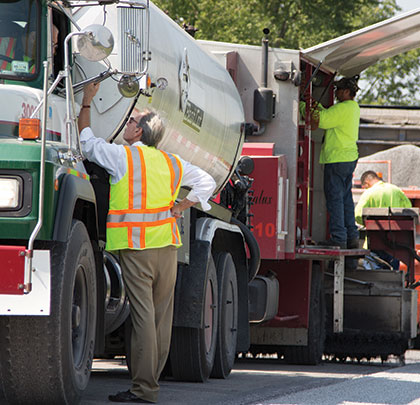Gorman, based in New York, repairs and resurfaces roads throughout New England and the Mid Atlantic. The family-owned company has been around since 1917 and has a long, proud history, but in 2008, the company’s leadership knew it needed to change.
In many ways, Gorman “did things the way they’d always been done,” says Kevin Nichols, the company’s vice president of operations and one of the key advocates for change. The company’s first goal was to consolidate three maintenance facilities and what were essentially three separate construction companies into one operation, Nichols says. Gorman has a fleet of more than 300 vehicles, and its 225 employees include crews spread up and down the East Coast.
NEW BUSINESS APPROACH
That effort to reduce maintenance costs led the company to consultant Preston Ingalls and Total Process Reliability. TPR is a structured business approach that targets equipment efficiency and asset management. Ingalls has been working as a maintenance and reliability consultant for 41 years, and his Raleigh-based consulting firm, TBR Strategies, specializes in helping companies use TPR to increase equipment uptime and lower repair costs.
For Gorman, Ingalls recommended a host of specific changes to focus on asset management and especially on preventive maintenance. That was nearly 5 years ago, and now Gorman has transformed the way it approaches maintenance, with its emergency repair rate dropping to 1.6 percent and maintenance expenses down $500,000 so far this year. The industry average for emergencies is close to 30 percent.
TPR also gave the company a systematic way to manage change—to improve how it operates and to do a better job explaining the new processes to employees, says Patrick Ryan, the company’s continuous improvement coordinator. For example, when the company adopted new job-tracking software and restructured its sales staff, it followed TPR’s “management of change” process both to make decisions and to explain them, he says.
Chip seal foreman Jim Brush believes that TPR has created a way for him to be more involved in helping the company. He leads a four-person crew that spends 4 months each year repairing roads in Connecticut. He had noticed that stone was building up in the radiator of chip spreaders and remembered that the company had lost a radiator 3 years ago because of stone buildup. Brush went to equipment manager Dan Corbett with a plan to add an additional filter, ultimately preventing the stone buildup.
ENGAGED EMPLOYEES
Co-owner Tony Gorman sees this boost in employee morale as a big benefit of TPR and believes employees have a better sense of being part of the company and of learning and growing.
“We now find ourselves listening to employee ideas more often, and that is a difference that TPR has created,” says Gorman, who owns the company with his brother, Mark. “They’re the people running the equipment. They’re the people we rely on for innovative solutions, and they feel a part of it.”
Gorman had tried other reform efforts in the past, but they had failed because of resistance, so when the company started TPR, some workers thought it was just another process that would be abandoned.
A few employees did leave because they couldn’t or wouldn’t adapt to the new approach, and Mark and Tony Gorman say owners have to be able to make hard personnel decisions, “to have the right people in the right position,” as the company wrote in its mission statement.
“I’ve noticed just in the last year that TPR is becoming more ingrained in the company,” Ryan says. “It’s just more fluid, and tasks are becoming more routine instead of being seen as extra work by the employees.” He offers the example of audits done on each piece of equipment to rate how well it has been maintained during the year. The company averages the audit scores for all of a crew’s equipment, creating an incentive for the foreman and crew members to work as a team.
“Teamwork is huge,” says Corbett, the equipment manager. “[Previously,] I don’t think anybody shared certain costs or financials with the guys. Now we put it on the TPR bulletin board: what our spend is on tires, on certain maintenance categories.” This helps workers to understand how their actions affect the company’s progress.
COMPANY COMMITMENT
Ingalls explained that TPR is a structured asset management process designed to engage the entire organization in taking better care of its assets, whether they are rolling stock or stationary facilities. The key is the organized approach backed by senior leadership.
Ingalls went on to say, “Without their unflinching dedication and consistent leadership, The Gorman Group would not be in the single digits in regards to emergency work. When they started, their Maintenance Cost as a percent of Fleet Replacement Value was 12.1 percent and now it is down to 2.8 percent. They stayed the course. It is now paying dividends.”
Gorman officials also emphasize that TPR isn’t complete. Gorman is constantly auditing itself, evaluating processes, and making changes. ■
About the Author:
Virginia Demaree Johnson is a freelance writer and editor based in Raleigh, North Carolina. She also has more than 12 years’ experience as a reporter, editor, and copy editor at newspapers in North Carolina and Virginia and for The Washington Post.
_________________________________________________________________________
Modern Contractor Solutions, October 2013
Did you enjoy this article?
Subscribe to the FREE Digital Edition of Modern Contractor Solutions magazine.

The TPR Difference


